
Review Article
Austin Biomol Open Access. 2022; 4(1): 1014.
A Comprehensive Review on: The Efficacy of Biocompounds of Leucas Aspera
AM Krupanidhi*; Asgar Ali; Amulya K; Ayesha Siddaika S; Aishwarya Kalal
Department of Pharmacology, Bapuji Pharmacy College-Davangere-577004, India
*Corresponding author: AM Krupanidhi Department of Pharmacology, Bapuji Pharmacy College-Davangere-577004, India. Email: dramkrupanidhi@gmail.com
Received: August 17, 2023 Accepted: September 25, 2023 Published: October 02, 2023
Abstract
The plant L. aspera derived biomolecules have potential efficacy against various gram positive and gram negative organisms. In-vitro activity depends on the ability of the antimicrobial agent to reach its microbial target site and to overcome various mechanisms of resistance in the infected bacilli. The effective biocompounds penetrate to the target site of organism must retain and exhibit significant activity at different concentration of the biocompounds. These biomolecules were nontoxic at dose levels and should not be metabolised to toxic intermediates. Are used on these clinical importance focused on review on L. aspera.
Keywords: L. aspera; Active biomoieties; Flavonoids; Glycosides; Antimicrobial activity
Introduction
The L. aspera is a holy plant and have divine value in India. This plant is widely distributed in India and which have there about 80 species of Leucas genus embrace available in Karnataka region. L. aspera plant is mostly looks like shrub, herbs with woody roots. The axillary or terminal inflorescence is usually with indeterminate augmentation. bracteoles are roughly erect and as per the vernacular name in kannada called as thumbe, in hindi called goma madhupati and telugu called as thummichittu which belongs kingdom plantae and belongs to family labiatae and genus Leucas and species aspera which contain secondary metabolites like Leucasperones A and B, alkaloids, alpha sitosterol and beta sitosterol, linifolia, apigenin, Amyl propionate, stearic acid, oleic acid, linoleic acid, phenolic compound, falconoid and this plant exhibits various pharmacological properties because of huge active biocompounds and it exhibits antimicrobial activity [1-15].
Taxonomical Classification: Kingdom: Plantae; Plant Subkingdom: Tracheobionta; Vascular Plant Super Division: Spermatophyta; Seed Plant Division: Angiosperma; Class: Dicotyledonae; Sub-Class: Gamopetalae; Series: Bicarpellatae; Order: Tubiflorae; Family: Labiatae; Genus: Leucas; Species: Aspera.
Vernacular Names: Sanskrit: Dronapushpi, Chitrapathrika, Chitrakshup; Punjabi: Guldor; Bengali: Darunaphula; Hulkasha; Gujarati: Kulnnphul; Hindi: Goma madhupati; Sindhi: Kubo; Maharashtra: Bahuphul; Bombay: Tumba; Telugu: Thummichittu.
Geographical Distribution
L. aspera commonly known as ‘Thumbai’ is found along roadsides and fallow fields from plains to 400m. It is found in Africa, Asia, Pacific Islands, South America and China. It is distributed throughout India from the Himalayas down to Ceylon [8]. In India and the Philippines L. aspera is a very common weed. It also found in a Bangladesh, Indo-China, and Malesia is a common aromatic herb found in Africa, temperate and tropical countries of Asia.
Morphological Description
L. aspera is an annual herb that erects to a height of 15 to 60 cm and has branches and a sturdy, hispid, abruptly quadrangular stem.
Stem
The stems have four conspicuous furrows, a quadrangular shape, are up to 4 mm thick, taste slightly bitter, and have a pale greenish-yellow surface texture [19].
Leaves
Yellowish-green, ovate or lanceolate, sub-acute, somewhat pubescent, up to 8.0 cm long and 1.25 cm broad, with an entire or crenate margin, serrate, and tasting pungent (Rai et al., 2005), with a sub-sessile or short petiole measuring 2.5 to 6 mm in length and being acute. The leaves are oriented opposite to one another, acute to acuminate, sessile, globose in shape, 2 to 3.5 cm in diameter, and encircled by a profusion of foliaceous bracts.
Flowers
Bracts are 6 mm long, linear, sharp, bristle-tipped, and ciliate with long, slender hairs. Flowers are white, sessile, small, dense terminal or axillary whorls. dense axillary, less frequently terminal, and typically distant whorls inflorescence.
Corolla
Corolla Upper lip: 3 mm long, thickly white-woolly, erect, concave, villous externally; tube: 5 mm long and pubescent above, annulate in the middle; lower lip: about twice as long, 3 fid, spreading, mid-lobe, bigger and the middle lobe absent, rounded; lateral lobes short, sub-acute. Four didynamous stamens, climbing under the upper lip, connivent anthers, divaricated cells, and lastly confluent stamens. A disc that is completely lobed, uniformly lobed, or occasionally expanded up front. (Khanam and Hassan, 2005) Nutlets are ovoid, triquetrous, obtuse to truncate, and rounded at the apex.
Root
The roots are long, smooth, cylindrical, and zigzag, and they have numerous wiry, tiny rootlets. The size varies, there are few cracks, and the fibrous material has a distinctive taste [19].
Fruits
Nutlets, also known as Schizocarpiccarcerules, are 2.5 mm long, brown, smooth, with an angular inner face and a rounded outer face (Hooker et al., 1984).
Seeds
The seeds are oblong, triangular, smooth, and dark brown in color, measuring 0.3 cm length by 0.1 cm wide.
Calyx
Calyx variable, tubular, 8 to 13 mm long; tube curved, contracted above the nutlets; mouth small, very oblique, not villous, the upper part produced forward; teeth small, triangular, bristle-tipped, ciliate, with the upper tooth being the largest. Ten nerved, frequently striate, mouth equal or oblique teeth 6–10 abnormally uneven, pubescent to hirsute teeth (Khanam and Hassan, 2005).
Pharmacological Activity
Hepatoprotective20:
The cold methanolic extract of the whole plant of L. aspera was reported to have significant hepato-protection in CCl4induced liver damage (Mangathayarau, et al., 2005). L. aspera leaves fresh juice was tested against carbon tetrachloride (CCl4) induced liver damage. The evaluation markers used were GOT, GPT, Alkaline phosphate, glucose, bilirubin, cholesterol and total protein. Silymarin was used as a standard for comparison. The fresh juice showed good result against liver disorders (Shirish and Pingale, 2010) hydroalcoholic leaf extract of L. aspera on male albino wistar rats was investigated, and shown significant hepatoprotective property.
Antioxidant Activity21:
Antioxidant property of L. aspera was reported by many researchers. The ethanol extract of L. aspera showed very potent antioxidant activity. Better antioxidant activity was observed in the petroleum ether extract of L. aspera leaf, and the order of the activity is petroleum ether > ethanol > isopropyl alcohol > ethyl acetate > chloroform. They also suggested ethanol or isopropanol (polar solvent selection) and petroleum ether (non-polar solvent selection) for better extraction of phytochemicals and phytoconstituents. Moreover, better antioxidant activity was observed in wild leaf extracts when compared to in-vitro callus extract.
Antibacterial Activity22:
It was observed that the chloroform and petroleum ether extracts of L. aspera Its root, flower, leaf, and stem exhibits good antibacterial activity against Staphylococcus aureus, Escherichia coli, Pseudomonas aeruginosa, Salmonella typhimurium, Salmonella choleraesuis, and Shigella flexneri [16]. The earlier study reported that the ethanolic and methanolic decoctions contain more active phytoconstituents than the water and these organic solvents showed better antimicrobial properties against various bacterial strains.
Central Nervous Activity23:
The root ethanolic extract of L. aspera was assessed employing pentobarbitone induced sleeping time test, the hole cross test and the open field test on Swiss albino mice for its impact on Central Nervous System (CNS). The results supported that L. aspera root may possess biologically active constituent (s) having CNS activity [30]. Furthermore, ethanolic extract of roots exhibited noteworthy peripheral antinociceptive activity at the concentration of 400 mg/kg.
Antihyperlipidemic –Activity24:
L. aspera leaves exhibit antihyperlipidemic action in an in- vivo animal model. Dexamethasone can be used to produce hyperlipidemia in rats, which results in a notable rise in TG and serum cholesterol levels as well as an increase in the atherogenic index. As a result of keeping serum levels of cholesterol and TGs close to normal levels, the ethanolic extract of leaves from L. aspera Linn. (200 and 400 mg/kg) therapy significantly inhibited dexamethasone-induced hyperlipidemia in rats.
S.
NoPhytochemical
CompoundSecondary metabolites
1.
Terpenes and Terpenoid compounds
Oleanolic acid, Ursolic acid, Squalene, β-caryophyllene, ahumulene, a-pinene, epia- a-bisabolol, Limonene, x-thujene, Menthol, Leucasperone A, Leucasperone B.
2.
Sterols and Fatty compounds
3-Sitosterol, 9,12,15-Octadecatrienoic acid methyl ester, nHexadecanoic acid, Linoleic acid, Oleic acid, Stearic acid, Ceryl alcohol.
3.
Glycoside compounds
Glucoside,Linifolioside,Leucasperosides-A Leucasperosides-B, Leucasperosides-C.
4.
Long chain compounds
(4-(24-Hydroxyl-1-oxo-5-n-propyltetracosanyl)-phenol), 28- Hydroxypentatriacontan-7-one, 7-Hydroxydotriacontan-2- one, 1-Hydroxytetratriacontan-4-one, 32- Methyltetratriacontan-8-ol, Nonatriacontane, 5- Acetoxytriacontane.
5.
Flavonoid compounds
Catechin, Acacetin, Apigenin.
6.
Lignane compound
Nectandrin B, meso-Dihydroguaiaretic acid, Macelignan, (-)- Chicanine, Licarin A, erythro-2-(4-allyl-2,6-dihydroguaiaretic1-(4-hydroxy-3-methoxyphenyl)propan-1-ol
7.
Miscellaneous compound
Nicotine alkaloids, Galactose sugar, 1,2 Benzenedicarboxylic acid bis(2-methylpropyl) ester, 1-Octen-3-ol, Amyl propionate, Isoamyl propionate, A.
Table 1: Phytochemical constituents [16-19].
Tissue
Extract
Activity
Whole plant extract
Ethanol extract
Anti-helmentic activity
Leaves
Ethanolic extract
Anti-hyperlipidemic activity
Whole plant
Ethanol extract
Anti-pyretic activity
Whole plant
Petroleum –ether extract, ethanol extract
Anti-psoriatic activity
Whole plant
Methanol extract
Antivenom activity
Leaf
Hydroalcoholic extract
Hepatoprotective activity
Root
Ethanol extract
CNS depressant activity
Flowers
Ethanolic extract
Antibacterial
Root
Methanol
Antioxidant
Table 2: Pharmacological value of L. aspera.
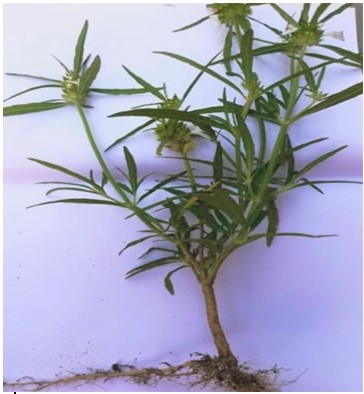
Figure 1: L. aspera plant.
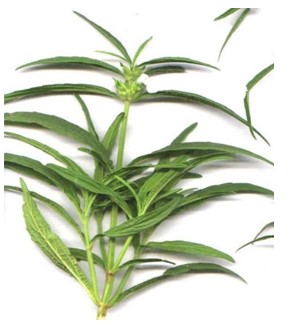
Figure 2: L. aspera stem.
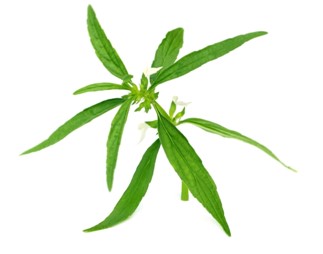
Figure 3: L. aspera leaves.
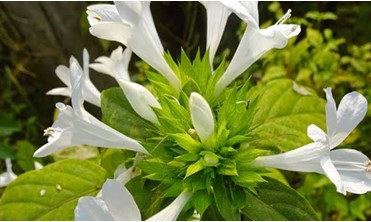
Figure 4: L. aspera flower.
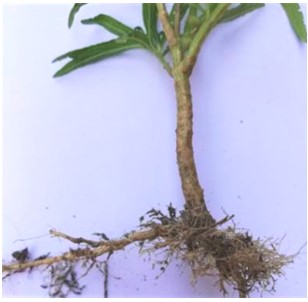
Figure 5: L. aspera root.
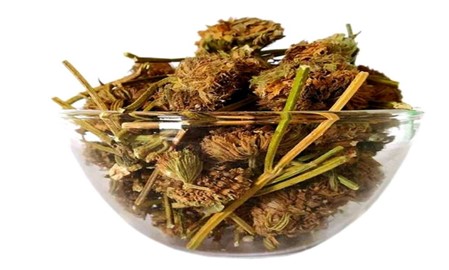
Figure 6: L. aspera seeds.
Dynamic Trajectory Analysis Against COVID-19 Spike Protein25:
In comparison to HCQ and Remdesivir, major phytoconstituents of M. Citrifolia and L. aspera, as well as the molecule 4- (24-hydroxy-1-oxo-5—n-propyltetracosanyl)-phenol from L. aspera, demonstrated significantly greater dynamic trajectory activity of forming the stable complex with S- protein and total denaturation of spike protein.
Anti-Pyretic-Activity26:
L. aspera and Glycosmis pentaphylla ethanol extracts were investigated for anti-pyretic effects in rats using a Brewer's yeast induced pyrexia model. The antipyretic action was demonstrated by the extract of L. aspera (200mg/kg) and the conventional paracetamol group over the course of the six-hour test period, most likely due to the inhibition of prostaglandin synthesis in the hypothalamus.
Anti-Psoriatic-Activity27:
Psoriasis-reducing action
The effects of C. juncea's petroleum ether extract and L. aspera's ethanol extract on nitric oxide production and lipid peroxidation on skin keratinocyte proliferation suggested anti-oxidant-mediated anti-psoriatic activity. Since the dawn of human civilization, herbal remedies for skin conditions have been documented.
Antivenomous –Activity28:
The L. aspera Linn. methanol extract was chosen for a thorough investigation into the isolation, purification, and characterization of the active chemical responsible for neutralizing the cobra venom. This compound was found to have strong antivenom activity.
Cytotoxicity29-30:
The cytotoxic and anti-tumor activities of natural and manufactured substances can be correlated using the brine shrimp lethality assay, which is a quick and affordable approach. The hydroalcoholic extract of the whole plant, particularly the root extract, showed cytotoxicity in several experiments of L. aspera using this model (LC50=1, 900 g/ml). In a test using brie shrimp, Morshed et al. discovered that the ethanol, ethyl acetate, and n-hexane extracts of L. aspera had LC50 of 114.70 g/ml, 43.97 g/ml, and 30.32 g/ml, respectively. In an in-vivo cytotoxicity against Artemiasalina (brine shrimp nauplii) was also investigated by Alam et al. They discovered that the dichloromethane fraction contains two active ingredients, amyrin and tocopherol, had cytotoxic effect, with LC values of 241 and 195 ppm, respectively.
Anti-ulcer Activity31:
Aspirin-induced ulcer and shay rat ulcer as experimental models to study the antiulcer efficacy of L. aspera alcohol extract. They concluded that this was due to an anti-secretory and protective effect on the stomach mucosa after observing a considerable decrease in acid secretion and a decrease in ulcer score in rats Reddy et al.
Anti-Parkinson’s Effect32:
Parkinson's disorder is a progressive neurodegenerative condition brought on by the loss of dopaminergic neurons in the midbrain's Substantia Nigra Pars Compacta (SNpc). Rotenone is an alkaloidal insecticide that is used to make animals develop Parkinson's disease. Through improved motor coordination, protective changes in oxidative marker levels, and no dopamine content loss, L. aspera ethanol extract was reported to protect rats from rotenone-induced Parkinson's disease.
Anti-Microbial Activity33:
When the methanol extract of L. aspera flowers, its fractions, the alkaloidal residue, and the expressed floral juice were examined for antimicrobial activity, the extract and methanol fraction showed good antibacterial activity, with the alkaloidal residue having the highest activity.
Anti-Inflammatory Activity34:
L. aspera leaf ethanolic extract shown considerable (p 0.001) anti-inflammatory efficacy in both acute and chronic inflammation at various dosages. Additional research could clarify its function in the management of inflammatory illnesses.
Antidiabetic Activity35:
In both streptazotocin- and alloxan-induced hyperglycemic rats, L. aspera extracts in ethanol and petroleum ether shown strong anti-hyperglycemic activity. Additionally, they might enhance the state of diabetes as shown by measurements such as body weight, blood cholesterol, and triglyceride levels. The L. aspera plant extracts were evaluated for their oral hypoglycemic and anti-diabetic properties .diabetic rats generated by alloxan and streptozotocin were tested for glucose oral tolerance.
The plant extract and isolated metabolites had strong anti-diabetic effects by increasing glucose absorption and modulating critical enzymes in glucose metabolism.
Antinociceptive Activity36:
The ethanolic extract of L. aspera root was tested for antinociceptive, antioxidant, and cytotoxic properties using acetic acid induced writhing inhibition, 1,1-Diphenyl-2-Picryl Hydrazyl (DPPH) free radical scavenging assay, and brine shrimp lethality bioassay, respectively. At dosages of 250 and 500 mg/kg, the extract significantly inhibited acetic acid-induced writhing in mice. With an IC50 of 8 g/ml, the extract demonstrated considerable free radical scavenging activity. The extract was deadly to brine shrimp, with an LC50 value of 0.
Conclusion
From the literature, L. aspera showed good antibacterial, antioxidant, anticancer, anti-inflammatory, anti-diabetic, and other effects.
L. aspera has a long history of use because of their great medicinal potential to treat and even cure a wide range of illnesses. L. aspera contains phenolics, glycosides, and terpenes that have high biological action. The investigations demonstrated a considerable reduction in both acute and chronic inflammation.
Therefore, there is still a ton of need for more scientific research on L. aspera to determine its medicinal effectiveness and economic viability.
References
- Ai Lan C, Jeyanthi J, Antony J, Sreenivasan S. Antioxidant and antibacterial activity of different parts of L. aspera. Asian Pac J Trop Biomed. 2012; 2: 176-80.
- Akter M, Khan MAI, Muhsin MDA, Hamid K, Obayed Ullah M, Bulbul IJ et al. In vitro studies on antibacterial, antifungal, and cytotoxic properties of L. aspera. Biol Med. 2012; 4: 183-7.
- Atchutkumar K, Satyanarayana T, Raj kiran K, Rajesh K. Antihyperglycemic activity of methanolic extract of L. aspera wild whole plant on blood glucose levels of streptozotocin-induced diabetic rats. 2013; 5: 2.
- Atiar Rahman M, Saiful Islam M. Antioxidant, antibacterial and cytotoxic effects of the phytochemicals of whole L. aspera extract. Asian Pac J Trop Biomed. 2013; 3: 273-9.
- Banu S, Bhaskar B, Balasekar P. Hepatoprotective and antioxidant activity of L. aspera against D-galactosamine induced liver damage in rats. Pharm Biol. 2012; 50: 1592-5.
- Chandrasekhar KS, Arun BJ, Satyanarayana D. Flavonoid glycoside from Leucas lavandulaefolia aerial parts. Asian J Chem. 2005; 17: 2853-4.
- Chatterjee SK, Majumdar DN. Chemical investigation of L. aspera. J Inst Chem. 1969.
- Chaudhury NA, Ghosh D. Insecticidal plants; Chemical examination of L. aspera. J Indian Chem Soc. 1969.
- Das BK, Das B, Arpita FK, Morshed MA, Uddin A, Bhattacherjee R, et al. Hannan phytochemical screening and antioxidant activity of L. aspera, IJPSR. 2011; 2: 1746-52.
- Gerige SJ, Yadav MK, Rao DM, Ramanjeneyulu R. GC-MS analysis and inhibitory efficacy of L. aspera L. Leaf volatile oil against selected microbes. Niger J Nat Prod Med. 2007; 11: 80-3.
- Goudgaon NM, Basavaraj NR, Vijayalaxmi A. Antiinflammatory activity of different fractions of L. aspera SPRENG. Indian J Pharmacol. 2003; 35: 397-8.
- Gupta N, Subhramanyam EVS, Sharma RK. Antidiabetic and Hypoglycaemic Activity of the Crude Extracts of the Plant L. aspera. 2015.
- Hedge IC. Labiatae. In: Ali SI, Nasir YJ, editors. Flora of Pakistan. Karachi: University of Karachi Department of Botany. 1990; 192.
- Humphrey AJ, Beale MH. Terpenes. In: Crozier A, Clifford MN, Ashihara H, editors. Plant secondary metabolites: occurrence, structure and role in the human diet. Oxford: Blackwell Publishing. 2006; 47.
- Ilango K, Ramya S, Gopinath G. Antibacterial activity of L. aspera spreng. Int J Chem Sci. 2008; 6: 526-30.
- Kumar GV, Devanna N. An update of L. aspera-a medicinal plant. Int J Sci Res Methodol. 2016; 5: 485-503.
- Srivastava J, Lambert J, Vietmeyer N. Medicinal plants: an expanding role in development [World Bank technical paper]. 1996; 320.
- Sabri G, Vimala Y, Mandlik PL. aspera: medicinal plant review. Int Res J Multidiscip Stud. 2015; 1: 1-8.
- Srinivasan R, Ravali B, Suvarchala P, Honey A, Tejaswini A, Neeraja PL. aspera-medicinal plant: a review. Int J Pharm Biol Sci. 2011; 2: 153-9.
- International research. October 15, 2015. Journal of Multidisciplinary Studies. Available from: http://www.irjms.in Email: irjms2015@gmail.com L. aspera: MEDICINAL PLANT REVIEW.
- INNOSC theranostics and pharmacological sciences. PHARMACOLOGICAL VALUES morphological, phytochemical, and pharmacological study of L. aspera: a review. 2019; 2: 1.
- Morphological, Phytochemical, and Pharmacological Study of L. aspera: A Review.
- International Journal of Agriculture Innovations and Research. ISSN. 6: 2319-1473.
- Kumar V, Devanna N. Antihyperlipidemic activity of leaf extracts of L. aspera Linn. against dexamethasone-induced hyperlipidemia in rats G. Asian J Pharm. 2016; 10: S408.
- Navabshan I, Sakthivel B, Pandiyan R, Antoniraj MG, Dharmaraj S, Ashokkumar V, et al. Computational lock and key and dynamic trajectory analysis of natural biophors against COVID-19 spike protein to identify effective lead molecules. Mol Biotechnol. 2021; 63: 898-908.
- Gupta N, Subhramanyam E, Jha S, Bhatia V, Narang E. A comparative antipyretic activity of the crude extracts of the plant L. Aspera and Glycosmis pentaphylla. J Chem Pharm Res. 2011; 3: 320-23.
- Singh SK, Chouhan HS, Sahu AN, Narayan G. Assessment of in-vitro anti psoriatic activity of selected medicinal plants. Pharm Biol. 2015; 53: 1295-301.
- Gopi K, Renu K, Jayaraman G, authors. Inhibition of Naja naja venom enzymes by the methanolic extract of L. aspera and its chemical profile by GC–MS. Toxicol Rep. 2014; 1: 667-73.
- Morshed MA, Uddin A, Saifur R, Barua A, Haque A. Evaluation of antimicrobial and cytotoxic properties of L. aspera and Spilanthes paniculata. Int J Biol Sci. 2011; 1: 7-16.
- Alam MS, Saha S, Lee DU. Antibacterial and in-vivo cytotoxic activities of the leaves of L. aspera. J Korean Soc Appl Biol Chem. 2014; 57: 551-4.
- Reddy MK, Viswanathan S, Thiugnanasambhantham P, Kameshwaran L. Antiulcer activity of L. aspera spreng. Anc Sci Life. 1992; 12: 257-60.
- Long-Smith CM, Sullivan AM, Nolan YM. The influence of microglia on the pathogenesis of Parkinson’s disease. Prog Neurobiol. 2009; 89: 277-87.
- Potential Antioxidant, Original Article Anti-Inflammatory and Antibacterial Evaluation Of Extracts Of L. Aspera Using In-Vitro Models.
- Patil, Somashekar Hs, Suneel Kumar Reddy, Vinod Nayak, Narendranath S, Kl Bairy. Evaluation of Anti-Inflammatory Activity Of Alcoholic Extract Of Leaves Of L. Aspera In Albino Rats Navin.
- Traditional Medicinal Plant L. Aspera Linn.: Gc-Ms Analysis, Chemical Examination, Antidiabetic, And Antiobesity Activities.
- MS Rahman, SK Sadhu, CM Hasan. Preliminary antinociceptive, antioxidant and cytotoxic activities of L. aspera root Author links open overlay panel.